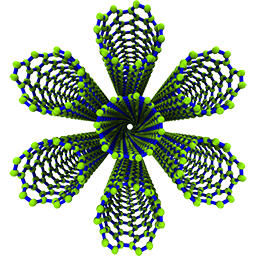# -*- coding: utf-8 -*-
"""
==============================================================================
Crystallography helper functions (:mod:`sknano.core.crystallography.extras`)
==============================================================================
.. currentmodule:: sknano.core.crystallography.extras
"""
from __future__ import absolute_import, division, print_function, \
unicode_literals
__docformat__ = 'restructuredtext en'
import numpy as np
__all__ = ['pbc_diff', 'supercell_lattice_points']
[docs]def pbc_diff(fcoords1, fcoords2):
"""Return the 'fractional distance' between two sets of
fractional coordinates, accounting for periodic boundary conditions.
Modified implementation of \
:func:`pymatgen:pymatgen.util.coord_utils.pbc_diff`
Parameters
----------
fcoords1, fcoords2 : array_like
Fractional coordinates. Either a single coord or any array of coords.
Returns
-------
fdiff : :class:`~numpy:numpy.ndarray`
Array of difference in fractional coordinates
`fcoords1 - fcoords2`, accounting for periodic boundary conditions.
Each coordinate must have the property that abs(fc) <= 0.5.
Examples
--------
>>> from sknano.core.crystallography import pbc_diff
>>> fc1 = [0.1, 0.1, 0.1]; fc2 = [0.3, 0.5, 0.9];
>>> pbc_diff(fc1, fc2)
[-0.2, -0.4, 0.2]
>>> fc3 = [0.9, 0.1, 1.01]; fc4 = [0.3, 0.5, 0.9];
>>> pbc_diff(fc3, fc4)
[-0.4, -0.4, 0.11]
"""
fdiff = np.subtract(fcoords1, fcoords2)
return fdiff - np.round(fdiff)
[docs]def supercell_lattice_points(supercell_matrix):
"""Generate the fractional coordinates of lattice points in a \
supercell lattice.
Modified implementation of \
:func:`pymatgen:pymatgen.util.coord_utils.lattice_points_in_supercell`
Parameters
----------
supercell_matrix : array_like
Returns
-------
frac_points : :class:`~numpy:numpy.ndarray`
numpy array of the fractional coordinates of lattice points
"""
diagonals = np.array(
[[0, 0, 0], [0, 0, 1], [0, 1, 0], [0, 1, 1], [1, 0, 0], [1, 0, 1],
[1, 1, 0], [1, 1, 1]])
d_points = np.dot(diagonals, np.asarray(supercell_matrix))
mins = np.min(d_points, axis=0)
maxes = np.max(d_points, axis=0) + 1
ar = np.arange(mins[0], maxes[0])[:, None] * np.array([1, 0, 0])[None, :]
br = np.arange(mins[1], maxes[1])[:, None] * np.array([0, 1, 0])[None, :]
cr = np.arange(mins[2], maxes[2])[:, None] * np.array([0, 0, 1])[None, :]
all_points = ar[:, None, None] + br[None, :, None] + cr[None, None, :]
all_points = all_points.reshape((-1, 3))
frac_points = \
np.asarray(np.dot(all_points, np.linalg.inv(supercell_matrix)))
frac_points = frac_points[np.all(frac_points < 1 - 1e-10, axis=1) &
np.all(frac_points >= -1e-10, axis=1)]
assert len(frac_points) == round(abs(np.linalg.det(supercell_matrix)))
return frac_points
